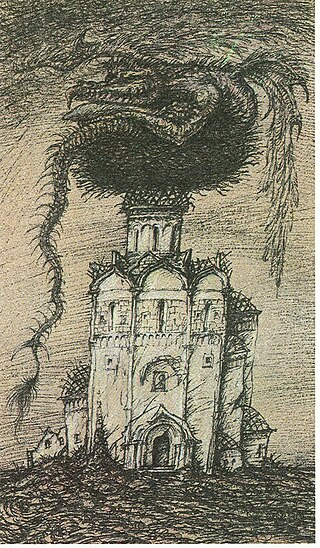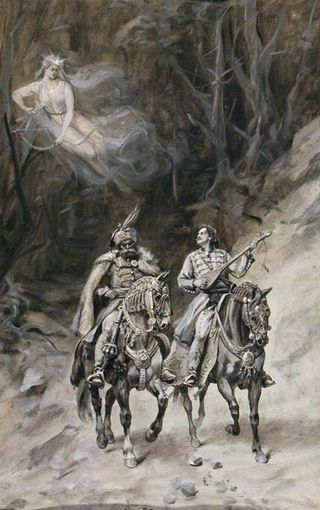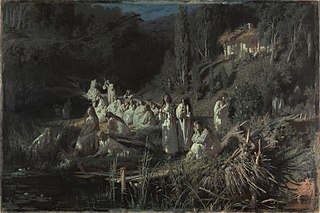Related Research Articles

Serbian epic poetry is a form of epic poetry created by Serbs originating in today's Serbia, Bosnia and Herzegovina, Croatia, Montenegro and North Macedonia. The main cycles were composed by unknown Serb authors between the 14th and 19th centuries. They are largely concerned with historical events and personages. The instrument accompanying the epic poetry is the gusle.

Zorya is a figure in Slavic folklore, a feminine personification of dawn, possibly goddess. Depending on tradition, she may appear as a singular entity, often called "The Red Maiden", or two or three sisters at once. Although Zorya is etymologically unrelated to the Proto-Indo-European goddess of the dawn *H₂éwsōs, she shares most of her characteristics. She is often depicted as the sister of the Sun, the Moon, and Zvezda, the Morning Star with which she is sometimes identified. She lives in the Palace of the Sun, opens the gate for him in the morning so that he can set off on a journey through the sky, guards his white horses, she is also described as a virgin. In the Eastern Slavic tradition of zagovory she represents the supreme power that a practitioner appeals to.
Slavic folklore encompasses the folklore of the Slavic peoples from their earliest records until today. Folklorists have published a variety of works focused specifically on the topic over the years.

A bogatyr or vityaz is a stock character in medieval East Slavic legends, akin to a Western European knight-errant. Bogatyrs appear mainly in Rus' epic poems—bylinas. Historically, they came into existence during the reign of Vladimir the Great as part of his elite warriors (druzhina), akin to Knights of the Round Table. Tradition describes bogatyrs as warriors of immense strength, courage and bravery, rarely using magic while fighting enemies in order to maintain the "loosely based on historical fact" aspect of bylinas. They are characterized as having resounding voices, with patriotic and religious pursuits, defending Rus' from foreign enemies and their religion. In modern Russian, the word bogatyr labels a courageous hero, an athlete or a physically strong man.

A Slavic dragon is any dragon in Slavic mythology, including the Russian zmei, Ukrainian zmiy, and its counterparts in other Slavic cultures: the Bulgarian zmey, the Slovak drak and šarkan, Czech drak, Polish żmij, the Serbo-Croatian zmaj, the Macedonian zmej (змеј) and the Slovene zmaj. The Romanian zmeu is also a Slavic dragon, but a non-cognate etymology has been proposed.

A kobzar was an itinerant Ukrainian bard who sang to his own accompaniment, played on a multistringed bandura or kobza.

Russian culture has been formed by the nation's history, its geographical location and its vast expanse, religious and social traditions, and both Eastern and Western influence. Russian writers and philosophers have played an important role in the development of European thought. The Russians have also greatly influenced classical music, ballet, sport, painting, and cinema. The nation has also made pioneering contributions to science and technology and space exploration.

Blind musicians are singers or instrumentalists, or in some cases singer-accompanists, who are legally blind.

Ukrainian literature is literature written in the Ukrainian language.

A vila, or víla[ˈviːla] is a Slavic fairy similar to a nymph.

In Slavic folklore, the rusalka is a typically feminine entity, often malicious toward mankind and frequently associated with water, with counterparts in other parts of Europe, such as the French Melusine and the Germanic Nixie. Folklorists have proposed a variety of origins for the entity, including that they may originally stem from Slavic paganism, where they may have been seen as benevolent spirits. Rusalki appear in a variety of media in modern popular culture, particularly in Slavic language-speaking countries, where they frequently resemble the concept of the mermaid.

Ostap Mykytovych Veresai was a renowned minstrel and kobzar from the Poltava Governorate of the Russian Empire. He helped to popularize kobzar art both within Ukraine and beyond. He is noted for influencing both scholarly and popular approaches to minstrelsy.

Pavlo Ivanovych Hashchenko ( -1933) was a Ukrainian kobzar and bandura player.
The Fiend or The Vampire is a Russian fairy tale, collected by Alexander Afanasyev as his number 363. The tale was translated and published by William Ralston Shedden-Ralston.

Ukrainian folklore is the folk tradition which has developed in Ukraine and among ethnic Ukrainians. The earliest examples of folklore found in Ukraine is the layer of pan-Slavic folklore that dates back to the ancient Slavic mythology of the Eastern Slavs. Gradually, Ukrainians developed a layer of their own distinct folk culture. Folklore has been an important tool in defining and retaining a cultural distinctiveness in Ukraine in the face of strong assimilatory pressures from neighboring lands.

A Russian fairy tale or folktale is a fairy tale from Russia.
Azerbaijani folklore is the folk tradition of Azerbaijani people which has developed throughout the centuries. Azerbaijani folklore is embodied explicitly in a large collection of narratives and implicitly in representational arts, such as vase painting and votive gifts.

Folklore of Russia is folklore of Russians and other ethnic groups of Russia.

The history of Ukrainian animation, which began in the late 1920s, is part of Ukrainian cinematography and has involved a variety of techniques, including frame-by-frame filming, time lapse, and three-dimensional pictures.
A Ukrainian fairy tale, "Kazka", is a fairy tale from Ukraine. The plural of казка is казки (kazky). In times of oral tradition, they were used to transmit knowledge and history.